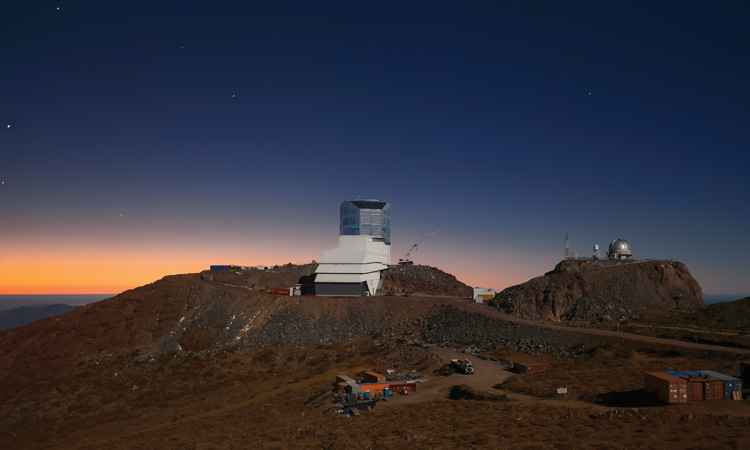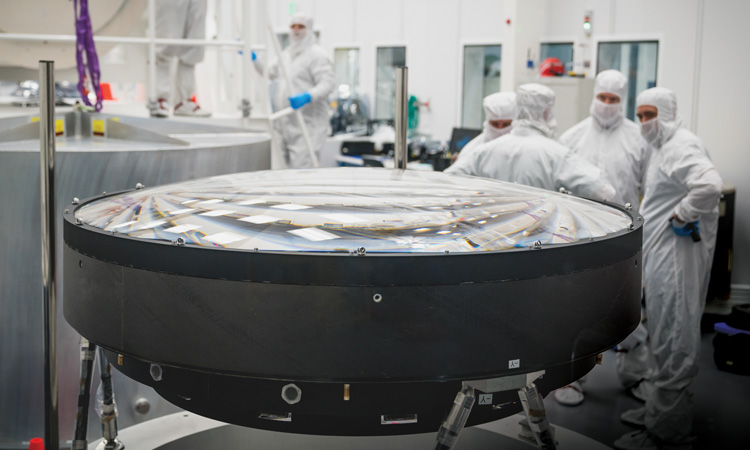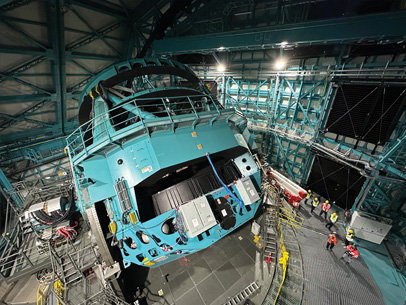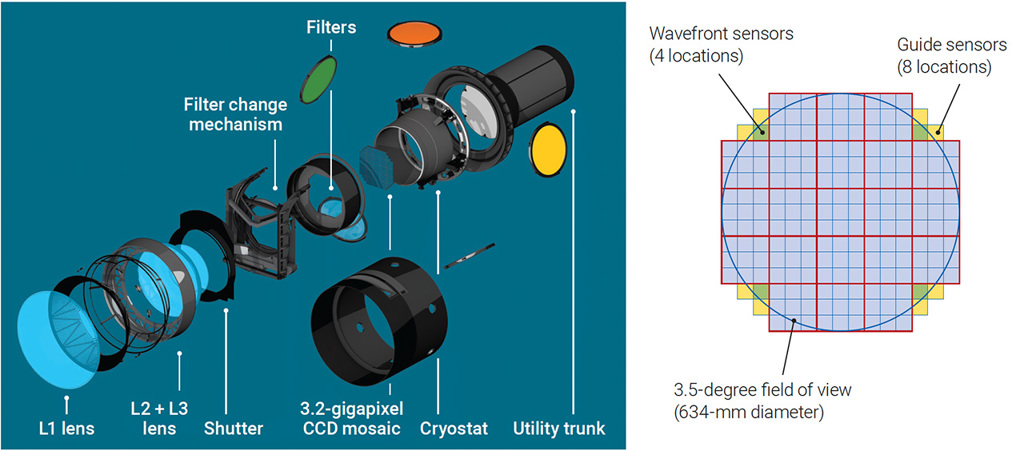 The Vera C. Rubin Observatory, a program of the US National Science Foundation’s NOIRLab, sits beneath a late-twilight sky in Chile. [Rubin Observatory / NSF / AURA]
The Vera C. Rubin Observatory, a program of the US National Science Foundation’s NOIRLab, sits beneath a late-twilight sky in Chile. [Rubin Observatory / NSF / AURA]
News, sports and fashion photographers rapidly point, click and move their cameras to capture the nuances of their subjects. Soon, astronomers will have their own fast-moving light bucket to record the mysteries of the heavens—the Vera C. Rubin Observatory, now nearing completion at a site 2663 m above sea level on Cerro Pachón, a mountain in northern Chile.
The Rubin Observatory’s comparatively squat telescope will zip around the firmament and snap a photo in less than a minute, over and over all night long across a period of 10 years.
While most telescopes aim a narrow field of view at a tiny patch of sky and stay there for a long exposure, the Rubin Observatory’s comparatively squat scope will zip around the firmament and snap a photo in less than a minute, over and over all night long across a period of 10 years. The wide-angle images that come from this survey may lead to unexpected discoveries at scales ranging from our solar system to the large-scale structure of the universe.
The Rubin has immense capacities to match its colossal mission. Granted, its 8.4-m primary mirror puts it only in the middle of the pack of modern ground-based professional telescopes. But it pushes boundaries in other metrics: the biggest CCD camera, at 3.2 gigapixels; the largest astronomical lens, at 1.55 m across; an extraordinarily broad view of 9.8 square degrees; and an anticipated 60 petabytes of visible- and infrared-wavelength data collected across 10 years.
 The Rubin Observatory’s 1.55-m lens, said to be the largest high-performance optical lens ever fabricated. [F. Abbott / SLAC National Accelerator Laboratory]
The Rubin Observatory’s 1.55-m lens, said to be the largest high-performance optical lens ever fabricated. [F. Abbott / SLAC National Accelerator Laboratory]
US scientists have viewed the Rubin’s sky survey as a top priority for more than a decade. But as the observatory approaches first light, scheduled for late 2024 or early 2025, Rubin scientists find they must address a threat never envisioned in 2010—constellations of shiny new satellites in low Earth orbit streaking across the telescope’s field of view.
Why survey the sky?
Astronomers use sky surveys to discover new objects and to study the changes in the sky over time. In the modern era, “a lot of the science we want to do is not observing individual astronomical objects, but statistically large samples of objects,” says Aaron Roodman, a physicist at the SLAC National Accelerator Laboratory, USA, who serves as a deputy director of the Rubin Observatory project.
The human urge to map and classify heavenly objects dates back to ancient times. In China, astronomer Shi Shen published a catalog and map of stars in the fourth century BCE. The Greek mathematician Hipparchus, in the second century BCE, compiled a larger catalog of stars and planets and their movements—data that may, a few hundred years later, have been incorporated into Ptolemy’s Almagest, which held sway in the West for more than a millennium.
With the advent of gelatin plate photography in the second half of the 19th century, astronomers began adding images to their star catalogs. One effort, the Carte du Ciel, employed 20 observatories and compiled a collection of 22,000 glass plates, but the project was left unfinished.
After World War II, the National Geographic Society, USA, funded the Palomar Observatory Sky Survey (POSS), which produced almost 2,000 glass photographic plates, each 36 cm square, exposed on the 1.22-m-aperture Schmidt telescope at Palomar Observatory, USA. Each plate covered approximately 36 square degrees of the sky, and each region of Northern Hemisphere sky was imaged twice—once using a red-sensitive plate and once using a blue-sensitive plate. Astronomers have found countless objects in the POSS photos, which also provided the foundation for many studies of galaxy morphology.
From LSST to Rubin
In the digital era, sky surveys have expanded beyond the visible spectrum (for example, the Two-Micron All-Sky Survey, or 2MASS) and to the Southern Hemisphere. The expansion prompted US astronomers in the late 1990s to consider building a dedicated survey telescope to catalog near-Earth objects that might threaten our planet, as well as supernovae and other deep-sky objects.
 The installed mounting assembly for the Rubin Observatory’s 10-m-long Simonyi telescope, November 2023. [Rubin Observatory / NSF / AURA / A. Alexov]
The installed mounting assembly for the Rubin Observatory’s 10-m-long Simonyi telescope, November 2023. [Rubin Observatory / NSF / AURA / A. Alexov]
The original team dubbed its proposed instrument the Large Synoptic Survey Telescope (LSST)—“synoptic” meaning “seeing the whole together”—and raised private funds to start the casting of the primary mirror in 2007. The project got a significant boost in 2010 when the US National Research Council’s 2010 decadal survey of astronomy priorities identified a wide-field, ground-based survey telescope as a top item. Site construction in Chile began in earnest in 2015 after the project secured funding from the US National Science Foundation (NSF) and the US Department of Energy (DOE)—due to the latter’s interest in the “dark energy” component of the universe’s energy density.
In late 2019 the US Congress renamed the LSST observatory after Vera Rubin (1928–2016), an American astronomer who studied the angular rotations of galaxies and who identified discrepancies supporting the presence of substantial amounts of mysterious “dark matter” in the universe. Once the observatory gained its new moniker, its team leaders found another use for the LSST initialism: it now stands for the Legacy Survey of Space and Time. The telescope that will hold the Rubin Observatory’s giant camera is called the Simonyi Survey Telescope, after Charles and Lisa Simonyi, who made a large private donation to the sky survey during the project’s early days.
Optics fit for purpose
Four science themes have driven the Rubin’s planned observing campaigns—and its design:
Dark energy and dark matter. The LSST will enable new studies of gravitational lensing, in which intervening masses distort the shapes of galaxies from Earth’s perspective. To make sense of these remnants of the expansion of the universe, astronomers need to observe as many galaxies as possible in as wide an area as possible, Roodman says.
Solar system inventory. Planetary scientists are always looking for trans-Neptunian objects in the far reaches of the solar system, as well as nearby asteroids and comets—especially those that might threaten Earth.
The transient optical sky. Transient objects caught by the Rubin’s repeated exposures could include supernovae, stellar flares, gamma-ray bursts, black-hole mergers and extrasolar planets that pass between Earth and their host star.
Mapping the Milky Way. Surveying Earth’s home galaxy may help astronomers understand the smaller-scale physics of dark matter and galaxy formation.
Many past sky surveys have looked at each region of the sky once, Roodman says, but the LSST will photograph each field of view at least 825 times over 10 years. The survey’s highly automated data pipeline will combine images of each region taken with different filters and compare images taken on different dates, to explore the sky in both space and time.
For a major observatory, the Simonyi telescope has an awesomely fast focal ratio: f/1.23. “If you know optics, that’s a huge challenge,” says Sandrine Thomas, a project deputy director based at the NSF’s NOIRLab in Tucson, AZ, USA. In comparison, the 10-m-aperture Hobby-Eberly Telescope in Texas, USA, has a focal ratio of f/3.65, while the James Webb Space Telescope’s ratio is f/20.
The Simonyi telescope’s 9.6-square-degree field of view is enormous for a telescope this size, Roodman says. That design requirement coupled with the focal ratio means that the telescope tube is only about 10 m long. The telescope needs to slew across the sky rapidly, and once it stops at a new position it needs to stabilize itself quickly.
Unlike most professional reflecting telescopes, which have primary and secondary mirrors, the Simonyi has three mirrors in the light path: an 8.4-m primary, 3.4-m secondary and 5.0-m tertiary. (To simplify the mechanical design and reduce jitter after each movement, Roodman says, the primary and tertiary mirrors share the same piece of glass.) The three-mirror design came about because, for the LSST’s purposes, the telescope must correct all three aberrations: spherical aberration, coma and astigmatism. A two-mirror Ritchey–Chrétien telescope, a variant of the traditional Cassegrain reflector used for many ground-based instruments as well as the Hubble Space Telescope (HST), does not correct astigmatism far from the center of the field of view.
 The 8.4-meter glass disk that will become the observatory’s primary–tertiary mirror undergoes polishing at the University of Arizona, USA. [Rubin Observatory / NSF / AURA]
The 8.4-meter glass disk that will become the observatory’s primary–tertiary mirror undergoes polishing at the University of Arizona, USA. [Rubin Observatory / NSF / AURA]
“With a two-mirror telescope, you’re usually stuck with smallish fields of view—20 arcminutes or less is typical,” Roodman says. The Rubin/Simonyi’s three-mirror anastigmat optical path has been called the Paul–Baker design, named after French optical scientist Maurice Paul and James G. Baker, the 1960 president of OSA (now Optica).
The famed Steward Observatory mirror laboratory, located under the bleacher seats of the sports stadium at the University of Arizona, USA, cast the primary–tertiary mirror combination from borosilicate glass back in 2007. It currently sits in a warehouse in Chile, and engineers have substituted an aluminum “twin” with the same shape and mass during construction of the telescope and the observatory building.
To keep the reflective surfaces aligned despite shifts in gravity’s pull and thermal expansion and contraction, the Simonyi will employ an active optics system. Four curvature wavefront sensors sit at the corners of the focal plane, at the interior corners of the cross-shaped sensor array, along with pairs of guide sensors and an alignment laser in the middle of the primary–tertiary mirror, Thomas says.
The Rubin camera design
The Simonyi will need to grab lots of photons quickly because of its strict cadence, or pattern of scheduled observations. The instrument will point at a region of the sky, take two 15-s exposures with its camera, and move on to the next region, all within a 39- to 45-s window. The two consecutive exposures will help the Rubin data management system winnow out random cosmic-ray hits.
 [Enlarge image]Left: An exploded view of the Rubin Observatory camera. Right: A diagram of the observatory’s focal plane array. Each of the 189 small blue squares—organized into 21 nine-sensor “rafts”—represents a 4096×4096-pixel CCD. [Rubin Observatory / NSF / AURA; Opt. Express 18, 1528 (2010)]
[Enlarge image]Left: An exploded view of the Rubin Observatory camera. Right: A diagram of the observatory’s focal plane array. Each of the 189 small blue squares—organized into 21 nine-sensor “rafts”—represents a 4096×4096-pixel CCD. [Rubin Observatory / NSF / AURA; Opt. Express 18, 1528 (2010)]
As noted, early photographic sky surveys required glass plates many centimeters across. But Rubin Observatory scientists figured as far back as the late 2000s that they would need 3.2 gigapixels across the focal plane to cover the wide field of view they envisioned for the telescope. (Compare that with the two Pan-STARRS telescopes in Hawaii, USA, whose two cameras have 2.9 gigapixels combined.)
The Simonyi’s camera, built at SLAC with assistance from Brookhaven National Laboratory, USA, does its imaging with 21 “rafts,” each a 3×3 array of 16-megapixel CCD detectors. According to Roodman, these silicon CCDs, called back-illumination deep-depletion devices, are sensitive to wavelengths between 350 and 1000 nm and have quantum efficiencies in the 95% range in the near infrared.
The camera has three huge lenses, the largest of which, at 1.55 m in diameter, landed in the Guinness Book of World Records as the biggest astronomical lens.
Because of the incredibly shallow depth of focus in the focal plane, Roodman says the CCD vendors had to make a significant effort to make the sensor chips as flat as possible; most otherwise passable chips have a slight “potato chip shape” that wouldn’t meet the observatory’s exacting specifications. To decrease noise, the CCDs are cooled to 170 K with a mixed-phase vapor compression system. To offload data from the sensors in just 2 s, each of the CCD chips was divided into 16 1-megapixel segments, each with its own readout.
The camera has three huge lenses, the largest of which is 1.55 m in diameter; it landed in the Guinness Book of World Records as the biggest astronomical lens, dwarfing the primary element in the 101.6-cm Yerkes Observatory refractor in Wisconsin, USA.
Handling the data flood
If all goes according to plan, the Rubin will generate about 20 terabytes of raw data every night and a staggering 60 petabytes across its entire 10-year mission. No human team could calibrate and process such enormous quantities of data, so Rubin officials are designing a data-processing pipeline to automate the procedures. The “prompt” data products, comparing fresh-off-the-CCD images with archived photos of the same sky position, will generate public alerts within 60 s of observation. Rubin officials expect millions of alerts every night. The pipeline, which includes supercomputing centers in the United States and France, will produce more thoroughly calibrated data sets on a daily and yearly basis.
Even before the observatory sees first light, its administrators are planning what to do with the US$680 million project after the 10-year LSST wraps up. In a 2019 white paper, the project science team noted the possibility that unexpected discoveries could lead to completely new uses for the telescope and camera. Other possible future tasks for the high-étendue instrument include finding optical counterparts to transient events found by other instruments, including gravitational-wave detectors. Replacing the camera’s filter set to perform photometry in different bands is a low-risk, cost-effective possibility.
More difficult and costly would be replacing the prime-focus CCD camera with a multi-object spectrograph, a near-infrared camera with either germanium or InGaAs sensors, or a camera equipped with high-quantum-efficiency “scientific CMOS” sensors. The latter two options would probably cost US$100 million or more. Of course, future plans will depend on the quality of the night sky as seen from Earth.
Looming threats in low Earth orbit
Through the LSST, the Rubin Observatory seeks to capture all four dimensions in space and time—producing the closest thing to a documentary movie astronomers have ever seen. But there’s a big “if.” Despite the Rubin Observatory’s impressive optics and specifications, the recent rise of satellite “megaconstellations” could throw a wrench into its ambitious plans, compromising the power of Rubin’s optical systems.
Despite the Rubin Observatory’s impressive optics and specifications, the recent rise of satellite “megaconstellations” could throw a wrench into its ambitious plans.
Over the past five years, astronomers worldwide have sounded the alarm over the large fleets of reflective satellites being lofted into low Earth orbit by private companies such as SpaceX, with the avowed aim of improving internet communications in remote areas (see OPN, May 2021, p. 26). While usually too dim to interfere with naked-eye viewing, the spacecraft can leave visible streaks across telescopes’ detectors. Not even HST, orbiting Earth at 539 km altitude, is immune; one recent study found that 2.7% of its wide-field images captured in the last two decades picked up a satellite trail.
The Simonyi telescope’s very wide field of view, though, makes the LSST particularly vulnerable to the threat. Bright spacecraft are more likely to cross its image area, possibly ruining many pixels or even entire images due to saturation, crosstalk, bloom or ghosting from internal reflections within the instrumentation. Roodman characterizes this as a “significant nuisance.”
 [Enlarge image]The apparent brightness of the Blue Walker 3 satellite as observed by the Steward Observatory on nine nights in November and December 2022. The rise of such satellite constellations will pose a significant challenge to the Rubin Observatory’s science mission. [S. Nandakumar et al., Nature 623, 938 (2023); CC-BY 4.0]
[Enlarge image]The apparent brightness of the Blue Walker 3 satellite as observed by the Steward Observatory on nine nights in November and December 2022. The rise of such satellite constellations will pose a significant challenge to the Rubin Observatory’s science mission. [S. Nandakumar et al., Nature 623, 938 (2023); CC-BY 4.0]
The number of actual satellite launches and applications for future launches have been increasing exponentially with time, while mitigation efforts “are at best linear,” says Tony Tyson of the University of California, Davis, USA, who is Rubin’s chief scientist and who has been LSST’s lead adviser on the issue of reflective satellites. “Exponential always wins.”
Approaching year-end 2023, more than 5,500 SpaceX Starlink satellites and 630 satellites from the UK-owned firm OneWeb were orbiting the planet. And companies from at least eight countries have asked the International Telecommunication Union (ITU) for permission to launch hundreds of thousands more. (In addition to their effects on the optical data, Tyson notes that such vast internet satellite constellations could produce “lots of bogus alerts,” potentially swamping the Rubin Observatory’s alerting system with noise.)
More worrisome than the SpaceX Starlink flotilla is BlueWalker 3, a satellite launched in 2022 by AST SpaceMobile, Texas, USA. The spacecraft, launched in September 2022, is a prototype of the company’s planned 90 satellites, designed to bring internet access directly to cellphones on the ground. That level of connectivity requires a big phased-array antenna: 64 m2, the largest telecom antenna in low Earth orbit. Last fall, an international observing team found that this white-colored antenna shone at an apparent magnitude of 0.4—brighter than all but eight stars in the night sky. (In astronomers’ reverse logarithmic scale, smaller numbers correspond to brighter objects.)
Countering the satellite threat
How big a threat all of this poses to a facility like the Rubin Observatory depends on imponderables like ultimate number of satellites, their brightness as seen from Earth, and how the telescope and its camera will actually respond. Simulations based only on the planned Starlink fleet found that at least 30% of LSST images would include at least one satellite trail; the hundreds of thousand of potential satellites from all players would affect a far larger percentage. According to Tyson, the spacecraft fleets could particularly imperil the Rubin’s search for Earth-threatening asteroids, which will focus on the sky close to the horizon, not long after sunset—when satellites will appear more numerous and brighter.
What can be done? “When you get down to it,” says Meredith Rawls, a research scientist with the Rubin Observatory at the University of Washington, USA, “the available mitigation strategies are really: launch fewer satellites; adjust hardware, orbits and maneuvers to make the satellites less visible; try not to point your telescope at them; and deal with the outcome when satellites do show up in your data.”
Barring a launch moratorium, which seems unlikely, astronomers have focused on dimming the satellites themselves. In 2019, Tyson contacted SpaceX, the parent company of Starlink, and found several employees who began studying the problem outside working hours. As Tyson recalls, the team came up with “this marvelous idea” of coating the bottom of a Starlink satellite with a darkening multi-layer dielectric film. Ground-based observations of the prototype “Darksat” just before the start of the COVID-19 pandemic showed that the darkening material reduced the reflected solar flux from the spacecraft by a factor of 2. Tyson notes, however, that other broadband companies are not making similar efforts—though Rawls says efforts continue to engage with the firms.
Observatory scientists are also hard at work on their own mitigation efforts. None is perfect, but together they might lessen the threat to the observatory’s mission.
One option is new algorithms that can mask the presence of a satellite trail and remove some of the residual artifacts in the data. Using actual data from the Japanese Subaru telescope (which has an 8.2-m aperture, close to Simonyi in size) and simulated data, Tyson and colleagues have tested the effectiveness of masks on satellite trails, though such masks will not cover all parts of the satellite trails. Here, too, the effectiveness depends on satellite brightness. The LSST team calculates that if all the satellites were darkened to magnitude 7, a net of only around 3% of LSST pixels would be lost, corresponding to a few months’ observing time. But the team also notes there’s no reason to think that most satellites will be dimmed that far.
Another tack being pursued involves tweaking the observatory’s scheduling algorithm. A study published at the end of 2022, coauthored by Rawls, suggested that such adjustments could reduce the fraction of LSST visits with a streak by a factor of two. Avoiding satellite trails in this way might require the sacrifice of 10% of the observatory’s total observing time, according to the study—a baleful prospect, but one that could become worthwhile if the number of satellites indeed grows into the hundreds of thousands.
Observatory astronomers acknowledge that the satellite constellations are going to make their job a lot harder. “Unfortunately, the same qualities that make Rubin such an amazing engine of discovery also make it vulnerable to large numbers of bright satellites,” says Rawls. And the team will “just have to do a bit more work” to handle that vulnerability as best it can.
Notwithstanding the satellite nuisance, though, Rawls remains bullish on the prospects of this remarkable observatory. “LSST will still do groundbreaking science; it will just be diminished somewhat by a hard-to-predict amount due to the situation in low Earth orbit,” she says. “I’m confident that LSST will still achieve amazing things.”
Patricia Daukantas is a freelance science writer based in Lanham, MD, USA.
For references and resources, visit: optica-opn.org/link/0224-rubin.

